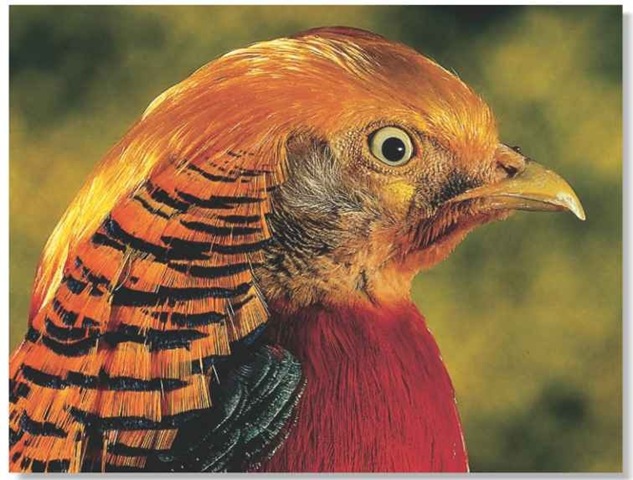ORDER
Galliform.es
FAMILY
Phasianidae
GENUS & SPECIES
KEY FEATURES
Male performs spectacular courtship displays, showing off his stunning plumage and long tail in order to attract a mate Female survives without food for over three weeks while incubating to ensure that the eggs are safe from predators
WHERE IN THE WORLD!
Native to central China, but is naturalized in Britain, chiefly in Norfolk and Suffolk; also Galloway in southwestern Scotland, Spain and most of France
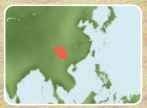
Lifecycle
One of the most brightly colored birds, the golden pheasant is surprisingly difficult to see as it skulks among bamboo in China or in the shade of British conifer plantations.
Habitat
The golden pheasant’s original habitat is markedly different from its adopted home in Britain. In its native China, the pheasant is found in rocky hill country where mountain slopes are clothed with bamboo thickets and low bushes. It spends virtually all its time in deep cover and avoids open country, where the showy male would be vulnerable to predators. It also shuns dense forest. Where its range overlaps that of the related Lady Amherst’s pheasant, the two birds occupy different zones due to subtle variations in habitat preference.
In Britain, the golden pheasant is a forest species confined to lowland areas. It sometimes occurs in mixed woods, but prefers
dense conifer plantations. It thrives where the crowns of pine and larch obscure light from the forest floor
Rare appearance
The golden pheasant rarely ventures from cover.

# Originally released in Britain for hunting, the golden pheasant proved unpopular because it does not fly when alarmed.
The golden pheasant is the most common pheasant in bird collections. Breeders have developed a variety that is pale yellow.
Breeding
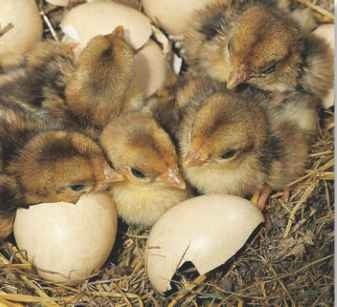
A Instant meals
The 5—12 chicks can feed themselves upon hatching.
The golden pheasant has a colorful courtship display that rivals even the famous birds of paradise. The performance is heightened by squeaks, clicks and whistles from the male, culminating in a snakelike hiss as he flicks up his golden cape and spreads his tail in the air Most males pair with only one female, but the most successful performers acquire harems of up to eight hens.
The female, whose nest is a simple scrape, is a devoted mother Even though her nest is well hidden, she sits continuously for more than three weeks, surviving on raindrops and dew. Once hatched, her chicks follow her from the nest. In two weeks they can flutter up to roost in trees.
Food & feeding
Bamboo buds, shoots and leaves form the bulk of the golden pheasant’s diet in the hills of China. It also eats flowers, including rhododendrons, which grow profusely in many valleys.
In Britain, the pheasant eagerly snaps up insects and spiders, which probably make up most of its diet as the conifer plantations it inhabits are devoid of undergrowth. It is thought to consume large quantities of ants as well, as it scratches through the fallen pine needle litter. It also eats grain provided by gamekeepers for ring-necked pheasants.
show business
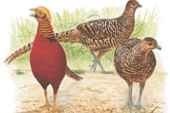
Sound effects
At the start of the breeding season, female golden pheasants answer a male’s crowing calls by visiting his territory.
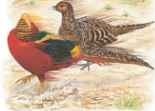
No way out…
One of the females is not interested and starts to walk away. But the male blocks her retreat by frantically racing around her in wide circles.

Final approach…
As soon as she stops, the male halts his circling maneuvers and rushes up to the female for the climax of his spectacular display.
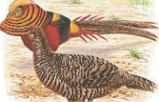
Look on the bright side
Posing side-on, he fans his cape over his face and slants his body towards her to show his golden rump and magnificent tail.
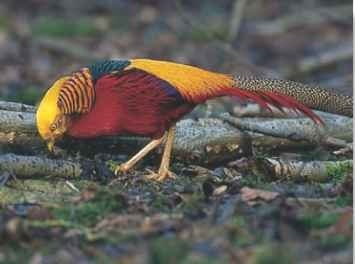
A picking a winner
The pheasant picks through low growth and leaf litter in search of fresh shoots and invertebrates.
Behavior
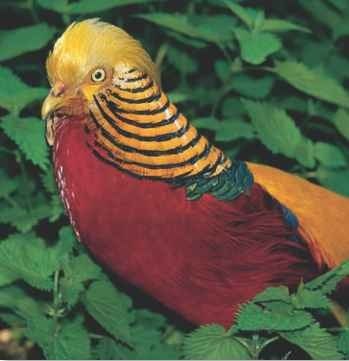
A nonflying colors
The pheasant usually only leaves the ground to roost.
A brief flash of fiery red as a golden pheasant dashes from cover across a woodland path is as much as a birdwatcher can hope to see of this elusive species in the wild. Although breeding territories are easily located from the male’s distinctive calls, he rarely ventures into the open. When disturbed, he sprints away on his long legs, zigzagging between trees or rocks until he finds a safe hiding place. The female employs a different technique to avoid predators. At the first hint of danger, she squats down and remains motionless, relying on her camouflage to escape detection.
The golden pheasant is generally solitary outside the breeding season. Males are aggressive toward each other in the presence of females, and fierce fights often break out between them.
Conservation
Although other pheasant species are in decline in China, the golden pheasant remains common there. In Britain, the feral population is fairly stable at 1,000-2,000 birds. It is unlikely to spread widely because suitable habitat occurs only in disjointed patches, and the bird has a sedentary nature.
PROFILE
Golden Pheasant
Few birds can rival the resplendent plumage of the cock golden pheasant, which he uses to attract as many females as possible.
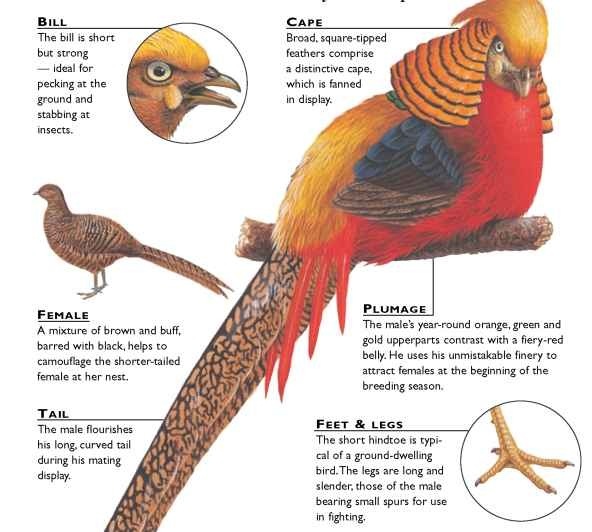
Creature comparisons
f Like the golden pheasant, Lady Amherst’s pheasant (Chrysolophus amherstiae) is native to China and naturalized in Britain.The two males have very different plumage. Lady Amherst’s pheasant is a little larger with legs and bill that are blue-gray not yellow. Both males have identical displays.The females look similar, but Lady ‘ Amherst’s hen has bolder barring.The birds are so closely related that they interbreed

| VITAL Weight |
STATISTICS 2.5-3.5 lbs. |
| Length [Head/Body Tail | Up to 20″ Up to 30″ . |
| WlNGSPAN | 26-30″ |
| Sexual Maturity -: | Male 2 years, female 1 year |
| Breeding j Season | April-May |
| Number of Eggs | 5-12 |
| Incubation Period | 22-23 days |
| Fledging [ Period | 12-14 days |
| Breeding 1 Interval | 1 year |
| Typical I Diet | Seeds, shoots, berries, leaves and insects |
| Lifespan | Up to 15 years |
Related species
The golden pheasant is I-of some 50 pheasant species; 26 occur in China. Pheasants are among 155 species in . 38 genera in the Phasianidae, the largest family in the order Galliformes. Other members of this family include partridges, francolins, tragopans, quails and junglefowl, the ancestors of domestic chickens.
